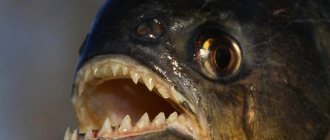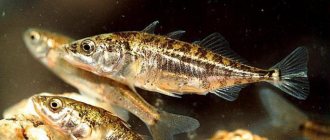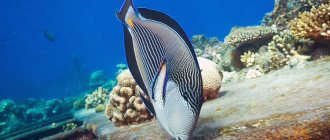Description of the fish
The maximum body length of an adult fish is 45-50 cm. Young individuals have a yellow tint, decorated with dark blue spots, which become green or blue as the specimens mature. The pattern is spotted, gradually disappears, and whitish spots form in its place.
zooclub.org.ua
The body of the fish is covered with an exoskeleton, represented by bony hexagonal plates. Between them there are gill and eye openings, and the fins have soft rays. The dorsal fin consists of 8-9 rays, the anal fin of 9, and the caudal fin of 10. The mouth is shaped like a beak, with fused teeth located inside it. The lifespan of a cube is 7-10 years.
Attractive unusual appearance is the reason for the popularity of cube bodies
In its “youth” it can easily be confused with a small floating cube, the yellow edges of which are decorated with dark blue dots. However, as it grows, the size of the cube body increases almost 10 times, and it gradually loses its bright, rich color and original shape. Over time, adult individuals change the color of their body from bright yellow to dirty olive, their body elongates in length, and the once dark blue circles turn into blurry spots of a yellow-blue hue. The fish's pectoral fins have to perform two functions: to swim and to push water through the gills. Just imagine that they make 3 swings per second!
Despite its apparent clumsiness, the body fish swims quite quickly, coping well with all its fins. But the frame of her body is hexagonal plates - a kind of hard shell with special holes for the tail, fins, gills and mouth. In addition to this reliable armor, Ostracion cubicus has another means of protection - mucus, secreted when danger approaches. Moreover, it is not secreted by the fish itself, but by the microorganisms that inhabit its stomach. But despite this double protection, the bodies are often eaten by large predators.
Boxfish distribution
This fish is found in the Red Sea, Indian and Pacific Oceans. The highest concentration of individuals is found in the tropical waters of East Africa, including the southern continent to the island of Ryuko, Hawaii, and Polynesia.
For its habitat, the fish chooses lagoons, coral reefs, and is found in shallow water with a depth of up to 35 cm, in areas with a rocky and sandy bottom. The fry live in small groups among the crevices of madrep corals of the genus Acropora.
Box fish live in small groups consisting of 1 male and 2-3 females.
In rare cases, the cubes rush to depth. They are very shy, so they try not to show themselves to anyone. Due to their innate slowness, they do not swim far from their shelters and hide at the slightest danger; adult specimens lead a solitary lifestyle.
reading.com.ua
Body
Bodies are fish with an unusual appearance. One glance at the box is enough to understand that it fully lives up to its name. In English they are called box fish or cow fish and both of these names are also true. The bodies constitute a separate body family, numbering 33 types. These amazing fish are related to aracans, triggerfishes and unicorns.
Male white-spotted boxfish (Ostracion meleagris).
The first thing that catches your eye when looking at a boxfish is its unusual body shape. It is angular in the bodies and varies in cross-section for different types from triangular to square. Such a strange appearance can be explained simply: the bodies have a real bone shell, formed by fused hexagonal plates. This shape of the plates is not accidental; it significantly increases the strength of the shell. Pointed ridges or spines may protrude on the surface of the shell. This physiological feature makes the box fish look like turtles, because the shell completely deprives the fish’s body of natural flexibility: only openings remain in it for the mouth, gill covers, caudal peduncle and fins.
The square outlines of the bodies turn them into real living boxes, and the supraorbital protrusions make the fish look like funny snails.
The boxer's mouth is often elongated into a short tube located on the underside of the body, but directed forward. These fish do not have pelvic fins, and the dorsal and anal fins are shifted to the caudal part of the body. The fins of the boxfish are tiny, which is why these fish cannot swim quickly. And the principle of operation of the fins is somewhat unusual: the fish does not row with them, but flutters like propellers. In a minute, the fins of the box can make up to 180 movements! The principle of movement of the box resembles a helicopter, so these fish are very maneuverable. The caudal peduncle of boxfish is thin compared to the thickness of the body, so the tail looks like a stubby appendage. However, the caudal fin itself in many species is quite wide and triangular in shape. The color of the bodies is spotty, often dominated by brown, yellow, and blue. The boxfish have no sexual dimorphism - males and females look the same, with the exception of the white-spotted boxfish, in which the females are black with white spots, and the males are blue-yellow. The dimensions of the bodies do not exceed 30-50 cm in length.
The eyes of the cowfish are large and protruding; in some species, like this common horned cowfish (Lactoria cornuta), the supraorbital projections are elongated in the form of pointed horns, hence the name cowfish.
All types of boxfish are heat-loving fish and live only in salty waters. They are found in the tropical and subtropical zones of the Atlantic, Indian and western Pacific oceans. Thus, the centers of species diversity are located near Australia and in the Indo-Malayan archipelago. They prefer to live in the shallow waters of coral reefs at a depth of 50-100 m (record 280 m), but currents can carry them far into the open ocean. These fish live alone and can be active at different times of the day. Bodies are calm and non-conflict fish. In aquariums, when attacked by other fish, they are defenseless and can get injured; in nature, they hide from danger in the crevices of the reef.
A female white-spotted boxfish explores a coral reef in search of food.
The bodies feed on a variety of animal foods. Their diet is based on various invertebrates: sea urchins, starfish, tunicates, crabs, sea cucumbers, sponges, foraminifera, polychaete worms and smaller living creatures. The carnivores, which prey on the smallest invertebrates, wash them out of the sand by releasing a stream of water from their mouths. In aquariums, hungry fish can even spit water, demanding food from the owner. Sometimes the boxfish eat algae and fouling, and the lumpy boxfish is the only species that has completely switched to feeding on plant foods.
The humpback or three-spined horned boxfish (Lactoria fornasini) has a sharp spine on its back.
During the breeding season, boxfishes stage mating games: the male circles around the female and together they rise high above the reef, sometimes to the very surface of the water. The body shell does not allow it to bear a large number of eggs, so the female spawns a few eggs that float in the water (pelagic eggs). The fry of the boxfish are also pelagic and are carried by currents far from the place of birth. At first, the fry swim in the water column, but having reached a length of 1 cm, they acquire a cubic shape, settle to the bottom and begin to live sedentary. Young bodies can differ significantly in color from adult individuals. For example, in the cube box, young fish are bright yellow with black spots, and adults are bluish with a barely noticeable yellow mesh pattern. Interestingly, all young individuals are females; with age they change sex and turn into males.
Mosaic plates of the shell are visible on the transparent body of a juvenile of the multi-spined horned body (Lactoria diaphana) from the Hawaiian Islands.
In nature, the boxfish is protected from small predators by a strong shell, which does not allow the enemy to grab and tear the victim. However, the boxfish are defenseless against large fish; such predators simply swallow the boxfish whole. However, the boxes themselves are not as simple as they seem. Their skin secretes a highly poisonous mucus that contains ostraciotoxin. The toxin gets its name from the Latin name for bodyfish because it is found only in these fish. In case of sudden fear or prolonged stress (including physiological illness), the bodies release toxin into the water. In a natural environment this does not matter, but in an aquarium it can lead to water poisoning. Water poisoned with ostraciotoxin begins to foam. The poison can lead to the death of fish, and in high concentrations, to the death of the bodies themselves.
Young cubic boxfish (Ostracion cubicus). These fish are kept in aquariums more often than other species.
Despite the poisonous nature of these fish, residents of the Antilles and Pacific Islands eat them. They roast the bodies over a fire without cutting them right in the shell, like chestnuts. The shells of captured (live) bodies are used as bright and unusual souvenirs. In addition, these fish are constantly caught for sale to aquarists, since they do not reproduce under artificial conditions.
For aquarists, bodies are a desirable, but difficult object. It is better to keep them separately from other species to avoid fish poisoning. If the boxfish are kept in a common aquarium, then the neighbors should be small and calm so that they do not frighten or disturb the boxfish. It is also not recommended to add invertebrates to the aquarium; the fish can eat them. The aquarium should be equipped with a powerful foam-absorbing filter with a large amount of activated carbon. In captivity, bodies are susceptible to disease. They eat any kind of food, as long as it is small (brine shrimp, finely chopped mussels, dried seaweed, grapes).
The white-striped red boxfish (Anaplocapros lenticularis) is a very rare Australian species with an unusual coloration for these fish. This type of body is very much appreciated by aquarists and is expensive.
By the way, thanks to the bodies, the designers of the Mercedes-Benz company created a revolutionary model of the Bionic Car. The bionic car follows the contours of the bodies of the bodies. It turned out that this design has a phenomenally low drag coefficient of 0.19, unattainable for other modern cars.
Read about the animals mentioned in this article: triggerfish, turtles, starfish.
Individual nutrition
The diet of specimens consists of algae, small arthropods, and small fish. The box's menu is dominated by mollusks, sea sponges and polychaete worms. Individuals obtain their prey using a thin stream of water released from the oral cavity towards the bottom.
Due to their dietary habits (consumption of poisonous algae), boxfish meat is toxic and is not eaten. The fish has mucus on its body that contains ostraciotoxin.
At the slightest danger, mucus production increases and the substance enters the surrounding space. This situation is dangerous for passing marine life.
When kept in an aquarium, the bodies run the risk of dying from autointoxication if they are under stress.
Behavior
A rather peaceful species, however, it has serious territorial appetites; in a small aquarium it will perceive everyone and everything as its enemies. If he has enough living space, he will be relaxed and calm. They are reluctant to get along with their relatives and often conflict over the same living space. But the most frightening thing for the boxfish, oddly enough, can be the owner of the aquarium - sharp sounds, movements and changes in lighting can greatly frighten him, and when frightened, the boxfish releases ostracitoxin, even a small amount of which can destroy the entire aquarium. Be careful and alert with this fish.
Fish reproduction
The fish lay few eggs. It swims in the surface layer of ocean waters, and the hatched larvae lead a pelagic lifestyle. Juveniles acquire a cubic outline, emphasizing their belonging to a specific species, when they reach a size of 1 cm.
zooclub.org.ua
At first, the juveniles become females, and then some transform into males.
Content
- 1 Description
- 2 Conditions of detention
- 3 Behavior
- 4 Food
- 5 Reproduction
Source:
Source: www.scuba-equipment-usa.com
- Other names: Ostracion cubicus, Yellow boxfish.
- Origin: Indo-Pacific region.
- Size: up to 45 cm.
- Temperature: 24-28 °C.
- Water parameters: pH 8.1–8.4, dkH 8–12.
- Behavior: peaceful, susceptible to stress.
- Content difficulty: high.
Keeping box fish in an aquarium
Cube is a difficult fish to keep at home, which is why it is recommended for experienced aquarists. It requires a spacious aquarium with a capacity of at least 300 liters. Since fish can release toxic substances, the principle of more is better. This will reduce the risk of intoxication of the specimen.
Classic reef aquariums are considered completely unsuitable for keeping. As they grow, the fish will definitely damage the decor. It is better to keep individuals in a classic saltwater aquarium. It can be specific or general, but food competitors cannot be chosen as neighbors; they will not be able to live peacefully. One box can live in one container, with the exception of formed pairs. A powerful filter, aerator, thermostat and lighting are required.
img1.liveinternet.ru
The cost of this fish is high; it can compete with other specimens included in our TOP of the most expensive fish.
Tell me, have you heard about this fish before? Share your impressions in the comments and be sure to write which representatives of the ichthyofauna are interesting to you. We will be happy to take your wishes into account in future publications.
Conditions of detention
Maintaining the body of a cube, as well as other bodies, is very difficult and is recommended only for experienced aquarists.
First of all, you will need a large aquarium with a capacity of 700 liters, or better yet 1000 liters. The bottom must be filled with various landscape elements in which the box could play and hide. There should be sufficient open space. Aquarium plants are also welcome, although not required. But it’s better not to add corals and invertebrates to it - it will eat. It is necessary to monitor the quality of water, remove waste and food debris in a timely manner. Lighting should not be bright or change sharply throughout the day. Also, do not frighten the box with sharp sounds.











